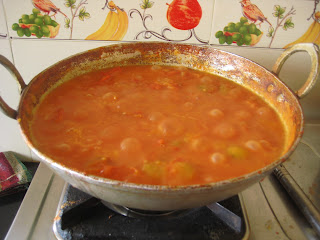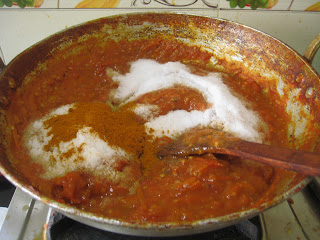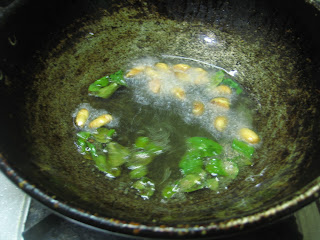Tomato Pickle / Instant Tomato Pickle (No Refrigeration)
Hurray! The season of tomatoes have come. Tomatoes are available all the year round but the price fluctuates. In this season the tomatoes are available at a very reasonable price and hence you can purchase loads of them and prepare
variety of pickles, sauces, juices, etc.,.
The moment we say tomato pickle, it reminds us of the favourite Priya Tomato Pickle in Andhra Pradesh. The colour and taste of the pickle is so mesmerising that it waters our mouths instantly. Mix this spicy tomato pickle with hot steamed rice with a dollop of ghee and the taste is heavenly.
Today's post is instant tomato pickle which is similar to the Priya pickle, even more better as it is prepared at home with simple ingredients. There are two methods for preparing this pickle - sun dried pickle and stove top pickle. The sun dried pickle is the traditional method where the tpmato pieces are marinated with salt and turmeric for 3 days and then sun dried until the tomato pieces become crisp. This pickle stays good for almost a year without refrigerating.
Today I am posting an easy and simple stove top instant tomato pickle. As the heading says, this instant tomato pickle does not require any refrigeration and stays good for almost like 3-4 months. The recipe was passed on to me by my neighbouring auntie who is an expert in preparing pickles and other traditional dishes. As mentioned earlier, tomato pickle goes well with hot rice. This can also be used with dosas, upma, roti, paratha and many other dishes as a side. So my dear readers, please go ahead and prepare this pickle during this season and enjoy with your family.
You might also like gongura ulli pachadi which is very easy to prepare and mouth-watering.
Also check easy and tasty coconut chutney.
Preparation
Choose big, firm and no-so-ripe tomatoes. Check for any holes on the outer skin of the tomatoes. If any, please discard them. Wash them properly with water and wipe with a kitchen towel-clean and neat. Take a large pan or a wok or a large cooker ( any one, which works best for you ). Heat the wok on a medium to high flame and add 7 tbsp. of oil. Put the tomatoes as a whole in the wok as shown in the picture.
Mix them carefully taking care not to drop them. Or If you have a larger wok, carefully hold the wok with both sides and toss them. Flip the tomatoes to both the sides such that they cook on both sides.
The tomatoes at the bottom of the wok are the ones to cook faster. So once the tomatoes at the bottom are cooked, gently replace the uncooked tomatoes to the bottom with a wooden ladle.
Repeat with all the tomatoes. When all the tomatoes are cooked evenly try mashing them so that the juices release from the tomatoes.
Keep mashing and stirring the tomatoes gently so that it doesn't get burnt at the bottom of the wok.
There should not be any water left in this mixture as shown in the picture.
The quantity almost becomes 1/3rd. This takes almost 45-60 minutes of cooking ( depending on the flame and the type of wok that you are using ).
Switch off the flame. Now take tamarind ( 2 such balls of the size as shown in the picture ),
and immerse in the tomato mixture as shown below.
Add salt and turmeric powder and mix well.
Add chilli powder and mix well.
When they are cool, grind them to a fine powder.
Add this powder to the completely cooled tomato mixture.
Mix well.
Grind this mixture to a coarse paste so that any lumps or tomato peels will get ground ( but not finely ). Do not grind the complete mixture at a time, take small portions and grind ( just a pulse or two ). This step can be avoided if you have mashed the tomatoes well during cooking.
Check for salt and spice. If you feel any of these are not sufficient, please add according to your taste buds. Heat oil in a pan and add mustard seeds and allow them to splutter.
Add the peeled garlic pods and fry until they turn to a golden yellow color.
Add hing and fresh curry leaves and fry until the sizzling sound reduces.
Allow this oil to cool completely. Add this oil to the tomato mixture and mix well.
Store in a clean glass or plastic jar.
Ingredients
Tomatoes - 2 1/2 kgs
Oil - 2 cups
Tamarind - 3 Big lemon sized
Salt - 1 cup
Turmeric Powder - 2 tsp
Chilli Powder 3 cups
To Dry Roast
Mustard Seeds 4 tbsp.Fenugreek Seeds 2 tbsp.
For Tadka
Mustard seeds 2 tspGarlic 15-17 pods
Curry Leaves 3 sprigs
Hing 1/2 tsp
Method
- Select big, firm and not-so-ripe tomatoes. Wash them properly and wipe with a kitchen towel such that there is no moisture on them.
- Heat a big wok or pan or cooker and pour 7 tbsp. oil in it.
- Add the tomatoes as a whole and cook on medium to high flame uncovered.
- Flip the tomatoes on both sides for even cooking. Replace the bottom most tomatoes that are cooked with the tomatoes that are uncooked. Repeat with all the tomatoes.
- Once the tomatoes are tending to become soft and the skin starts to peel off, gently mash them with the wooden ladle so that the juices release.
- Cook this mixture until there is no moisture left and the mixture becomes pulpy.
- Switch off the flame. Add tamarind to the mixture and cover the tamarind with the mixture on all sides.
- Add salt, turmeric powder and chilli powder and mix well. Allow the mixture to cool completely. Keep it in a dry place to avoid water or water droplets falling into it.
- Dry roast mustard seeds on a low flame until the sizzling sound stops and transfer to another plate.
- Dry roast fenugreek seeds on a low flame until they come to a brownish color and a nice aroma comes out of it. Keep stirring continuously. Transfer to the mustard seeds plate and allow both to cool completely.
- Grind mustard and fenugreek seeds to a fine powder and add this to the tomato mixture when it is completely cool.
- Mix well and keep aside.
- Grind this mixture portion by portion to a coarse paste to avoid any lumps of tomato that are not mashed well during cooking process. This step is optional. This can be avoided if you have mashed the tomatoes well during cooking.
- Heat another pan and oil to it. Add mustard seeds and allow them to splutter. Add garlic pods and fry until they turn to a golden yellow colour.
- Add hing and curry leaves until the sizzling sound reduces and remove from flame.
- Allow this oil to cool completely and add to the tomato mixture.
- Mix everything well and check for salt and spice. If required, add more.
- Transfer to a dry glass jar and store in a cool dry place.
Notes
- I have used country tomatoes ( round in shape ) and not the hybrid ones ( oval in shape ).
- Always use dry woks, ladles and spoons while preparing and after the preparation of the pickle. The jars in which the pickle is stored should also be neat and dry.
- Take care to store the pickle in a dry place. Even a small contact with moisture will leave the pickle spoiled.
- The basic preservatives that are used in this pickle are salt, tamarind and oil. So do not hesitate on adding enough salt, tamarind and oil.
- Add salt and chilli powder slowly and gradually. Do not add the mentioned quantities directly in a lump. The taste buds might not be the same for everyone. So add gradually, little by little. Initially add 3/4 cup of salt and check the taste. If not sufficient, add little. Add 2 cups of chilli powder and check for taste. If not satisfied, add more.
- The oil should coat the pickle. If the above mentioned quantities does not coat the pickle, then add more oil and mix well.
- I actually forgot to add the dry red chillies during the tadka. Please do add broken red chillies for extra flavor and taste. The appearance also changes when we add the red chillies. It is very appealing for the eyes.
- I have used home made chilli powder made from Guntur red chillies.
- This pickle does not require any refrigeration if you have added enough preservatives and taken proper care to avoid any moisture.
If you have any doubts, please shoot. I will be ready to answer and clarify any of your questions. Happy pickling!


































No comments:
Post a Comment